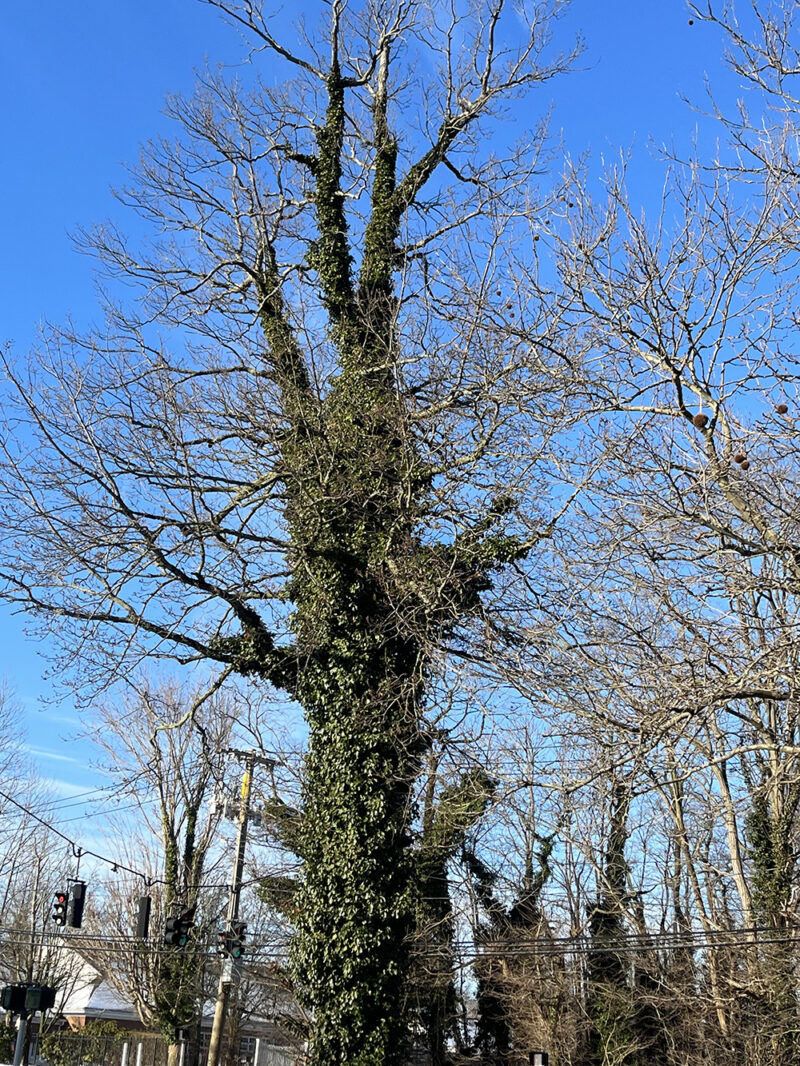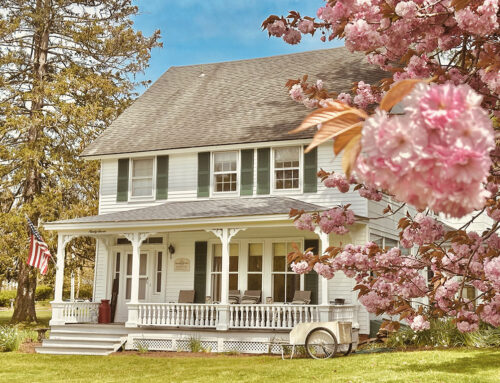The Three Village Community Trust’s First Annual Awareness Campaign that’s
Simply De-Vine
What’s green, spreads rapidly, is found everywhere, and is destructive to trees?
 English Ivy. What’s not to love?
English Ivy. What’s not to love?
You’ll see it climbing on trees in different areas throughout the Three Villages. And it blankets the ground of many areas with its dark green leaves and graceful tendrils. It also has a royal look- think large estates or even the ivy-covered walls of those prestigious colleges.
Interestingly, the English Ivy (Hedera Helix) you commonly see was brought to North America by English settlers yearning for reminders of the old country.
Today, English Ivy grows throughout the northeast, and it has ‘rooted’ itself’ on Long Island in particular. It is found in landscaped beds, climbing on stone walls and chimneys, and climbing the trunks of trees. English Ivy is an inexpensive groundcover and is an effective way to stabilize soil on steep slopes and hills.
English Ivy – It is a Menace!
English ivy will gradually destroy everything you love – ok, maybe that’s a little dramatic – but it will make you pay a price for falling in love with its graceful looks.
You see, those tiny little roots or tendrils adhere to everything – slowly penetrating the surface of tree bark, mortar, wood trim, siding – anything that is not moving. For trees, English Ivy is deadly – the plant’s rootlets carry leaf scorch – a bacteria that is harmful to the tree, and it’s these tendrils that will open the bark to even more bacteria and fungus. English Ivy can suffocate a tree by shielding it from needed sunlight. And, during storms, the ivy creates a ‘sail’ effect, allowing high winds to catch the trunk and branches of the tree and bring it down. If you let the ivy climb over parts of your home, you will eventually find yourself paying big bills for repairs to damaged chimneys, shingles, trim, and siding.
Worse of all, allowing English Ivy to ‘climb’ will contribute to the rapid spread of this invasive species. Once ivy climbs high enough to be nourished by bright sunlight, it will produce small berries. Birds will eat these berries, and ivy seeds will be distributed far and wide through bird droppings. Yikes!
What to do if it is spreading on the ground …
While there are a number of solutions, the best is not to let it get started – don’t plant it and don’t transplant it. If you have it on your property continue to cut it back. Dispose of the pulled plants by bagging it up for your yard waste pickup. (Too many of people ‘dump’ their yard waste in public spaces, like the sides of roadways or parks, – allowing the spread of this creeping, crawly menace to take hold and spread …. and spread …. and spread …. )
What to do if the ivy is climbing on your trees.
You need a few things:
- Safety glasses
- Work gloves
- A small mallet or hammer
- Pruning shears and/or hack saw
- Small puller bar, crowbar, or nail puller
After donning your ‘safety gear,’ you need to clip the vines growing up the trees. Work at a comfortable height, though the closer you work to the base of the tree, the better. Keep in mind, anytime you work outside you could be exposed to ticks and poison ivy. Wear appropriate clothing and wash up with soap and water after your outdoor activities! It’s a good idea to wash all of your clothing, also.
Now, let’s get to work and do some damage to English Ivy!
Identify the trees with ivy climbing on their trunks. Most trees in our area do not show ivy leaves in the first six or seven feet of growth – the deer have eaten it. But the vines are still there, and the leaves of the ivy can be seen as you look up.
Gently pry a section of the vine off the tree and clip it with your shears, or if the vine is too thick, use the hack saw. (Hack saws are less likely to inadvertently hurt you in the cutting of the vines and do a good job cutting the bigger vines.) You do not want to harm the bark of the tree so use the pry bar to ‘lift’ each vine off the tree. Sometimes, you’ll need a mallet or hammer to tap the pry bar and get under the vine.
Work your way around the tree, until all the vines are clipped. After clipping each vine, if possible, grab the bottom part of the vine you just cut and pull it off the tree. Leave the upper portion.
Over time, the upper vines will wither and die, and will eventually fall from the tree. You will have to revisit your trees every couple of years to clip any new vines from climbing up your trees. Think of it as one of the routine yard maintenance jobs.
Your trees will love you for it!
Take part in the Three Village Community Trust’s effort to eliminate the spread of English Ivy in our area. This is our first English Ivy Awareness Campaign, and we are calling it “Simply De-Vine.”
Need more information:
https://www.invasive.org/alien/pubs/midatlantic/hehe.htm




